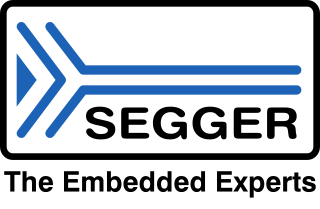Related Research Articles
The Portable Operating System Interface is a family of standards specified by the IEEE Computer Society for maintaining compatibility between operating systems. POSIX defines both the system and user-level application programming interfaces (APIs), along with command line shells and utility interfaces, for software compatibility (portability) with variants of Unix and other operating systems. POSIX is also a trademark of the IEEE. POSIX is intended to be used by both application and system developers.
RTLinux is a hard realtime real-time operating system (RTOS) microkernel that runs the entire Linux operating system as a fully preemptive process. The hard real-time property makes it possible to control robots, data acquisition systems, manufacturing plants, and other time-sensitive instruments and machines from RTLinux applications. The design was patented. Despite the similar name, it is not related to the Real-Time Linux project of the Linux Foundation.
In computing, POSIX Threads, commonly known as pthreads, is an execution model that exists independently from a programming language, as well as a parallel execution model. It allows a program to control multiple different flows of work that overlap in time. Each flow of work is referred to as a thread, and creation and control over these flows is achieved by making calls to the POSIX Threads API. POSIX Threads is an API defined by the Institute of Electrical and Electronics Engineers (IEEE) standard POSIX.1c, Threads extensions .
Nucleus RTOS is a real-time operating system (RTOS) produced by the Embedded Software Division of Mentor Graphics, a Siemens Business, supporting 32- and 64-bit embedded system platforms. The operating system (OS) is designed for real-time embedded systems for medical, industrial, consumer, aerospace, and Internet of things (IoT) uses. Nucleus was released first in 1993. The latest version is 3.x, and includes features such as power management, process model, 64-bit support, safety certification, and support for heterogeneous computing multi-core system on a chip (SOCs) processors.

FreeRTOS is a real-time operating system kernel for embedded devices that has been ported to 35 microcontroller platforms. It is distributed under the MIT License.
Eclipse ThreadX is a highly deterministic, embedded real-time operating system (RTOS) programmed mostly in the language C.

Segger Microcontroller, founded in 1992, is a private company involved in the embedded systems industry. It provides products used to develop and manufacture four categories of embedded systems: real-time operating systems (RTOS) and software libraries (middleware), debugging and trace probes, programming tools, and in-system programmers. The company is headquartered in Monheim am Rhein, Germany, with remote offices in Gardner, Massachusetts; Milpitas, California; and Shanghai, China.
DSPnano is an embedded real-time operating system (RTOS) which is compatible with POSIX and embedded Linux. It was first created in 1996 and was one of the first pthread based real-time kernels. Its entire focus was on tiny real-time digital signal processing systems and has been optimized to deliver high performance DSP on embedded digital signal controllers and digital signal processors. Its parent was the Unison Operating System.
TI-RTOS is an embedded tools ecosystem created and offered by Texas Instruments (TI) for use across a range of their embedded system processors. It includes a real-time operating system (RTOS) component named TI-RTOS Kernel, networking connectivity stacks, power management, file systems, instrumentation, and inter-processor communications like DSP/BIOS Link. It is free and open-source software, released under a BSD license.

ChibiOS/RT is a compact and fast real-time operating system supporting multiple architectures and released under a mix of the GNU General Public License version 3 (GPL3) and the Apache License 2.0. It is developed by Giovanni Di Sirio.
EFM32 Gecko MCUs are a family of mixed-signal 32-bit microcontroller integrated circuits from Energy Micro based on ARM Cortex-M CPUs, including the Cortex-M0+, Cortex-M3 and Cortex-M4.

XtratuM is a bare-metal hypervisor specially designed for embedded real-time systems available for the instruction sets LEON2/3/4, ARM v7 and V8 processors and RISC-V processor.

QP is a family of open source real-time embedded frameworks (RTEFs) and runtime environments based on active objects (actors) and hierarchical state machines. The QP family consists of the lightweight QP/C and QP/C++ frameworks, written in C (C99) and C++ (C++11), respectively.
RT-Thread is an open-source real-time operating system (RTOS) for embedded systems and Internet of things (IoT). It is developed by the RT-Thread Development Team based in China. RT-Thread is aimed to change the current situation in China that there is no well used open-source real-time operating system in the microcontroller field.
Mbed is a development platform and real-time operating system (RTOS) designed for internet-connected devices that utilize 32-bit ARM Cortex-M microcontrollers. These internet-enabled devices are often categorized under the Internet of Things (IoT) umbrella. The Mbed project is a collaborative effort led by Arm Holdings, in partnership with various technology companies and contributors.
NuttX is a free and open-source Real-Time Operating System (RTOS) with an emphasis on technical standards compliance and on having a small footprint. Scalable from 8-bit to 64-bit microcontroller environments, the main governing standards in NuttX are from the Portable Operating System Interface (POSIX) and the American National Standards Institute (ANSI). Further standard application programming interfaces (APIs) from Unix and other common RTOSes are adopted for functions unavailable under these standards, or inappropriate for deeply embedded environments, such as the fork system call.

Apache Mynewt is a modular real-time operating system for connected Internet of things (IoT) devices that must operate for long times under power, memory, and storage constraints. It is free and open-source software incubating under the Apache Software Foundation, with source code distributed under the Apache License 2.0, a permissive license that is conducive to commercial adoption of open-source software.

FatFs is a lightweight software library for microcontrollers and embedded systems that implements FAT/exFAT file system support. Written on pure ANSI C, FatFs is platform-independent and easy to port on many hardware platforms such as 8051, PIC, AVR, ARM, Z80. FatFs is designed as thread-safe and is built into ChibiOS, RT-Thread, ErlendOS, and Zephyr real-time operating systems.
William (Bill) Lamie is an American software engineer. He is known as the author of the Nucleus, ThreadX and PX5 real-time operating systems (RTOS).
References
- ↑ "PX5 RTOS Simplifies Development of 64-bit Hard Real-Time Applications with Support for IAR Embedded Workbench for Arm". Yahoo! Finance . San Diego. 12 June 2023. Retrieved 22 August 2023.
- ↑ Janakiram MSV (21 April 2019). "How Does The Express Logic Acquisition Help Microsoft And The IoT Ecosystem". Forbes . Retrieved 1 September 2023.
- ↑ Wiggers, Kyle (18 April 2019). "Microsoft acquires Express Logic for its real-time internet of things operating system". VentureBeat . Retrieved 1 September 2023.
- ↑ "Bill Lamie: Story of a man and his real-time operating systems". embedded.com. 3 September 2010. Retrieved 31 August 2023.
- ↑ "William Lamie". Electronic Design . Retrieved 31 August 2023.
- ↑ Tuip, Martin (9 June 2021). "Building IoT solutions with RTOS". Microsoft Tech Community . Retrieved 31 August 2023.
- ↑ Flaherty, Nick (26 March 2023). "Nucleus RTOS hits 30, boosts safety certifications". eeNews Europe. Retrieved 31 August 2023.
- ↑ Jagdale, Saumitra (27 February 2023). "PX5: a new RTOS for real-time multithread scheduling in under 1KB". Embedded.com. Retrieved 29 August 2023.
- ↑ "IAR Systems Fully Supports the Brand-new Industrial-Grade PX5 RTOS". Automation.com. 26 January 2023. Retrieved 29 August 2023.
- 1 2 3 Maxfield, Max (9 February 2023). "New PX5 RTOS Boasts Native Support for POSIX pthreads API". Electronic Engineering Journal. Retrieved 25 August 2023.
- ↑ "Reducing safety and security risks for embedded systems". MMG Publishing. Retrieved 29 August 2023.
- ↑ "PX5 Launches PX5 NET to Reduce Development Effort & Risk in TCP/IP Networking for Embedded IoT Applications". Yahoo! Finance . San Diego, USA. 7 November 2023. Retrieved 8 January 2024.
- ↑ "IAR Systems implements PX5 RTOS for its IAR Embedded Workbench". IoT Now. 17 June 2023. Retrieved 29 August 2023.
- 1 2 3 4 "Product of the Week: PX5 RTOS with Arm TrustZone Support". Embedded Computing Design. 1 May 2023. Retrieved 27 August 2023.
- ↑ Bush, Steve (26 January 2023). "IAR Systems adds support for PX5 industrial-grade RTOS". Electronics Weekly . Retrieved 29 August 2023.
- 1 2 Haywood Queen, Karen (6 May 2023). "Clarinox, PX5 Partner to Improve Embedded Device Connectivity". Electronic Engineering Times . Retrieved 27 August 2023.
- ↑ Cox, Chad (27 January 2023). "Percepio's Tracealyzer 4.6 Supports PX5 RTOS". Embedded Computing Design. Västerås, Sweden. Retrieved 27 August 2023.